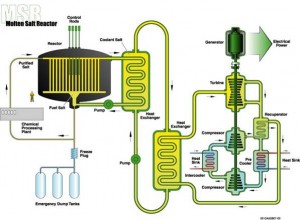Mar
2
The Best Liquid Fueled Reactor Review
March 2, 2009 | 2 Comments
Lots of people realize that vast energy supplies would lead to lower costs to do work, make portable fuels and trigger an economic boom. Leaving out the media and the politicians, the sense is that electrification is fundamental to those of us watching and learning. Storage of electricity at lower costs and higher volumes is coming.
Yet the availability of electrical power supplies is rife with complexities. The global warming, the pollution concerned, ratepayers and investors are all looking for a way to provide cheap power with low investment, low environmental issues and low operating costs.
These criteria point to a system that is more than 35 years old. The Oak Ridge National Laboratory spent over 15 years developing thorium and other heavy element fuels using liquid fuel reactor systems. What that means is the fuels were in liquid solutions versus solid fuel or gas forms. As with portable fuels, liquid fuel offers some advantages. Whether thorium, uranium or plutonium using one of the liquid reactors designs offers a fascinating path to a lower cost future.
The graphic is one common thorium molten liquid salt reactor. In these designs (in a very simplified explanation) the fuel and carrier chemicals are heated to a molten state for reaction. The liquid fuel is a solution of reactive elements diluted with other elements such that the proportions control the activity that is managed chemically using chemical processing technology. This is far safer than relying on a hot reacting core which needs control rods both to control output but provide a means to stop a reaction. Should a liquid system get to hot; it can just be dumped safely, too cold and it freezes up.
Liquid fuel reactors have other important advantages. Low pressures remove the risks of explosions, control rods can be designed to be unnecessary, simple plugs that melt so opening to the dumps provides certain safety, they can be used to destroy the current inventory of used nuclear fuel while getting more power form the used fuel, and can use thorium, a cheap fuel that might last hundreds of thousands of years. Add to those the aspects that make proliferation or acquisition by dangerous folks from getting explosive grade nuclear materials almost impossible and practically uselessness for terrorists, liquid fuels should be of major an intense public interest. They are, in Russia, France, Japan, India and others.
Which brings me to the youtube video given to the Google Tech Talk group on February 19th 2009. This is David LeBlanc, a Canadian with a great interest in fission and fusion reactor designs. He’s currently teaching at Carleton University, researches in the field of molten slat reactors and has founded Ottawa Valley Research Associates, which has licensed some of his ideas with a European firm to develop a new generation of molten salt reactors.
The video is a very fast paced hour that covers reactor in general and liquid fueled reactors in more detail. LeBlanc ends with some of his innovations that have lead to interest from other countries. It’s quick, thorough and highly useful way to get right up to speed as of February 2009.
Where are the Americans in all of this? Most of the activity is at a blog rather than at corporate or university research. Energy From Thorium is the outstanding U.S. site for information, ideas and education serving the entire world. There are hundreds if not thousands of page of old Oak Ridge National Laboratory work ready for perusal. Its getting perused, just not used by the U.S. power industry as far as anyone can tell. It’s a kind of resource base that opens the door to other nations to sell back to the U.S. the technology researched and developed here to begin with. Strange, that the U.S. ignores a huge inventory of certain and measurable potential.
Comments
2 Comments so far



[…] the original post here: The Best Liquid Fueled Reactor Review | New Energy and Fuel Share and Enjoy: These icons link to social bookmarking sites where readers can share and […]
The LFTR is a very simple, efficient, and elegant type of reactor. It can use any kind of nuclear fuel, bomb material, or nuclear waste product to produce very high temperature heat and at the same time breed more fuel in the bargain. This thrifty approach to nuclear energy greatly appeals to me, but I became even more interested in the LFTR when the details of a new patent were revealed by LeBlanc ends. It opens up the possibility of building a reactor that can run for 30 years without refueling in an unattended mode sited underground while it breeds new fuel within the thorium structure of the reactor itself. In order to get to this U233 that has been produced inside the very walls of the reactor containment vessel, a proliferator must destroy the reactor, chop it up into small pieces while enduring heavy gamma radiation exposure without being detected, then reprocess these reactor pieces using isotopic separation since the U233 is denatured with enough U238 to make chemical separation of bomb grade U233 impossible. Now, this is a tall order for any proliferator and may just be an impossible assignment.
At the end of the service life of the Lftr, the reactor vessel is sent back to the factory where it is reduced to liquid fluoride salts that become the feedstock of a next new Lftr. This feedstock can only be used by the new Lftr and not for bombs. The waste products and held at the factory for a few hundred years to cool down before they are mined for the many precious elements contained within like platinum and iridium. Now that’s what I call a safe, efficient and thrifty mode of operation.